Wellness Workbench: Crafting a Healthier Workshop
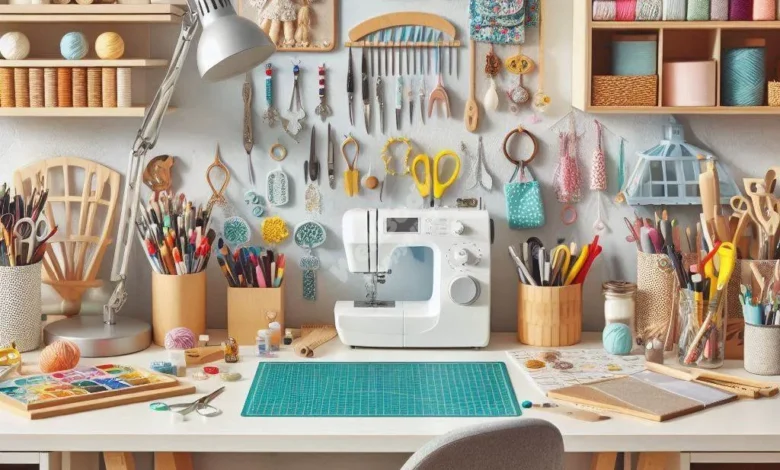
Imagine a workspace where creativity flows freely, and your health thrives alongside your craft. Welcome to the concept of the “wellness workbench” – a revolutionary approach to craftsmanship that puts your well-being at the forefront.
In today’s fast-paced world, it’s easy to get caught up in the pursuit of productivity, often at the expense of our health. But what if we told you that by creating a healthy craftsmanship environment, you could not only boost your creativity but also enhance your overall wellness?
This blog post will guide you through the essential tools and strategies to transform your workspace into a haven of health and productivity.
Understanding the Craftsmanship Environment
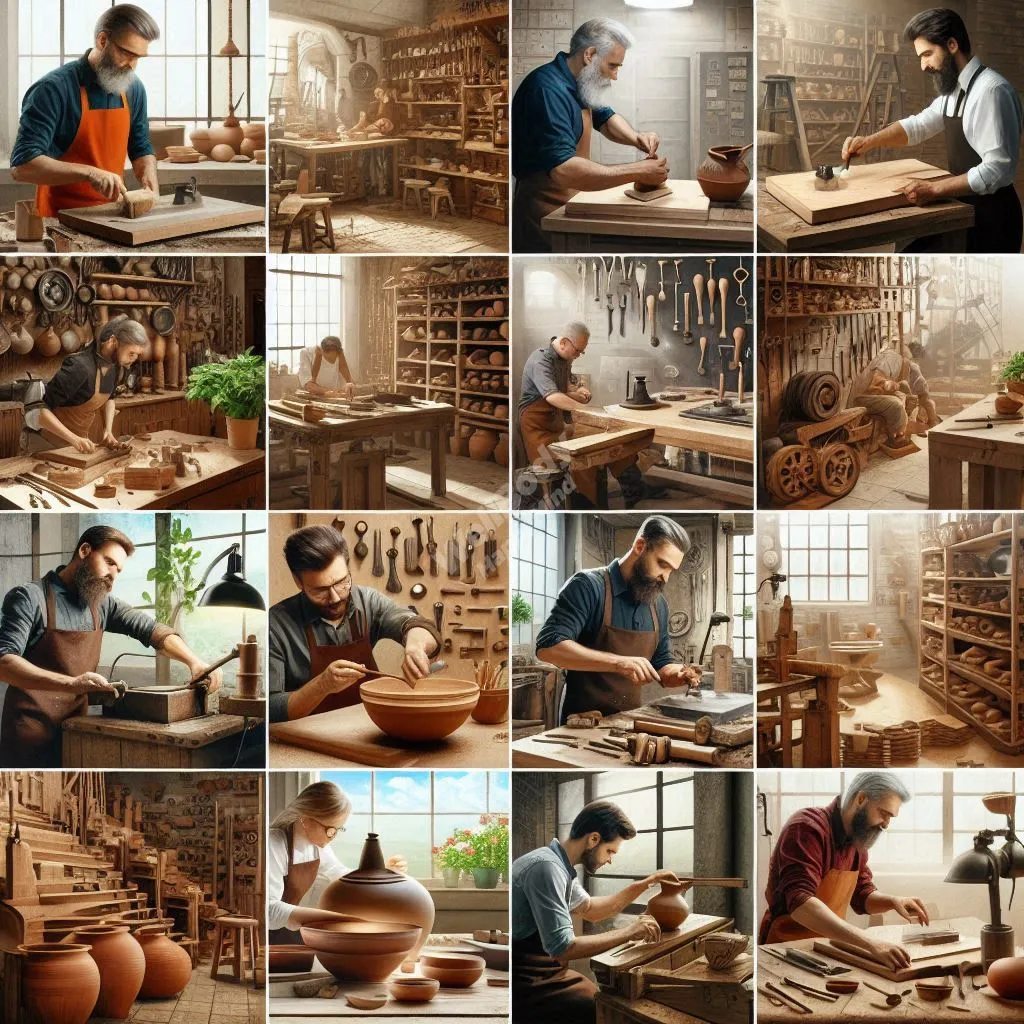
A craftsmanship environment is more than just a workspace – it’s a place where skill, creativity, and passion come together. Whether you’re a woodworker, metalsmith, potter, or any other type of artisan, your workspace plays a crucial role in your craft and well-being.
However, these environments often come with health risks that many crafters overlook:
- Exposure to dust and fumes
- Poor posture from long hours of work
- Eye strain from inadequate lighting
- Hearing damage from loud equipment
- Stress from disorganized spaces
To create a truly healthy craftsmanship environment, we need to take a holistic approach. This means considering not just the physical aspects of your workspace, but also how it affects your mental and emotional well-being.
By addressing these elements together, we can create a wellness workbench that supports both your craft and your health. In the following sections, we’ll explore practical tools and strategies to achieve this balance.
Ergonomic Tools and Equipment
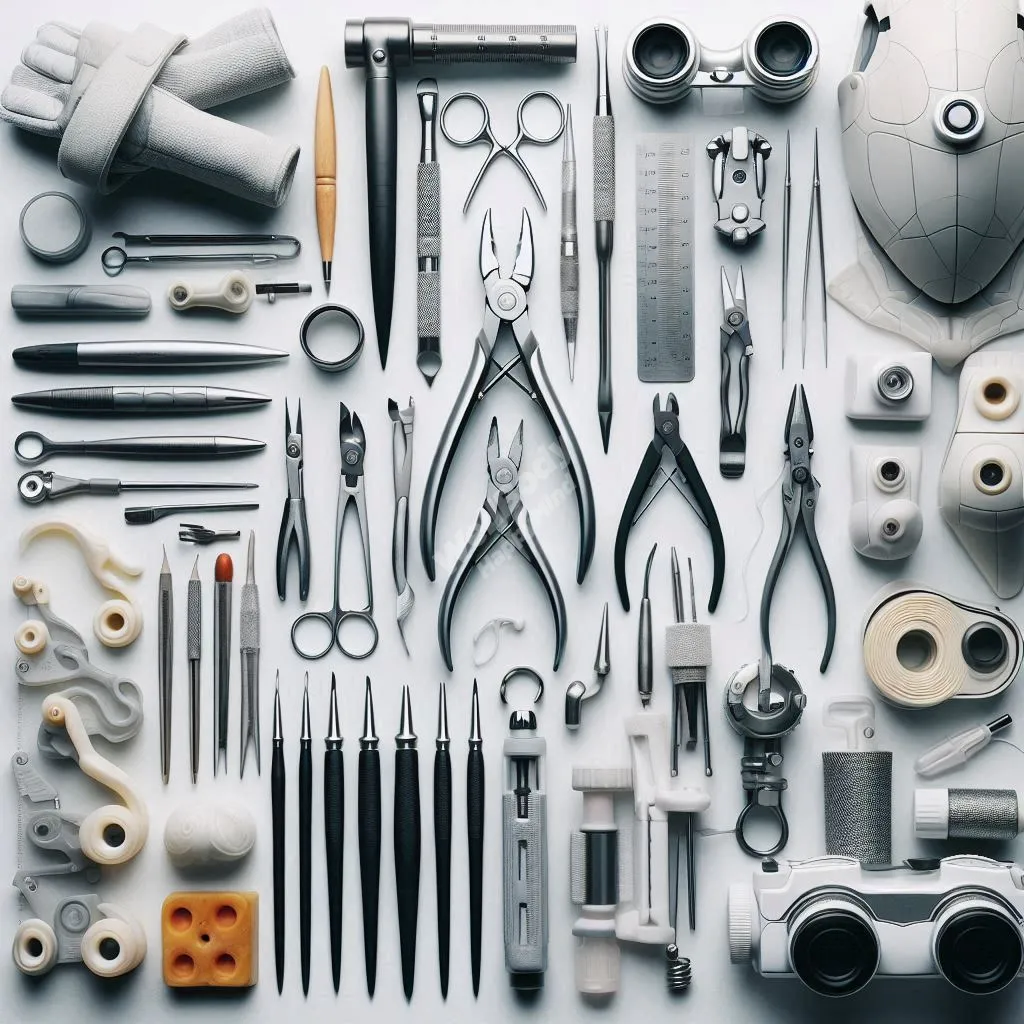
Creating a healthy craftsmanship environment starts with the right tools. Ergonomic equipment can significantly reduce physical strain and improve your overall comfort while working.
Adjustable Workbenches
An adjustable workbench is a cornerstone of the wellness workbench concept. These versatile pieces of equipment offer several benefits:
- Reduce back strain by allowing you to work at the optimal height
- Accommodate different tasks and projects
- Improve posture and circulation
When choosing an adjustable workbench, look for these features:
- Easy height adjustment mechanism
- Sturdy construction for stability
- Ample work surface area
- Built-in storage options
Ergonomic Seating Options
Proper seating is crucial for maintaining good posture during long crafting sessions. Consider these ergonomic seating options:
- Adjustable stools with back support
- Saddle chairs for improved posture
- Standing desk stools for alternating between sitting and standing
- Kneeling chairs for reducing lower back pressure
Hand Tools with Ergonomic Designs
Ergonomic hand tools are designed to reduce strain on your hands, wrists, and arms. They can make a significant difference in your comfort and productivity. Some examples include:
- Curved-handle screwdrivers
- Padded-grip pliers
- Angled paintbrushes
- Soft-grip hammers
By investing in these ergonomic tools and equipment, you’re taking a big step towards creating a healthy craftsmanship environment that supports your well-being and enhances your craft.
Proper Lighting Solutions
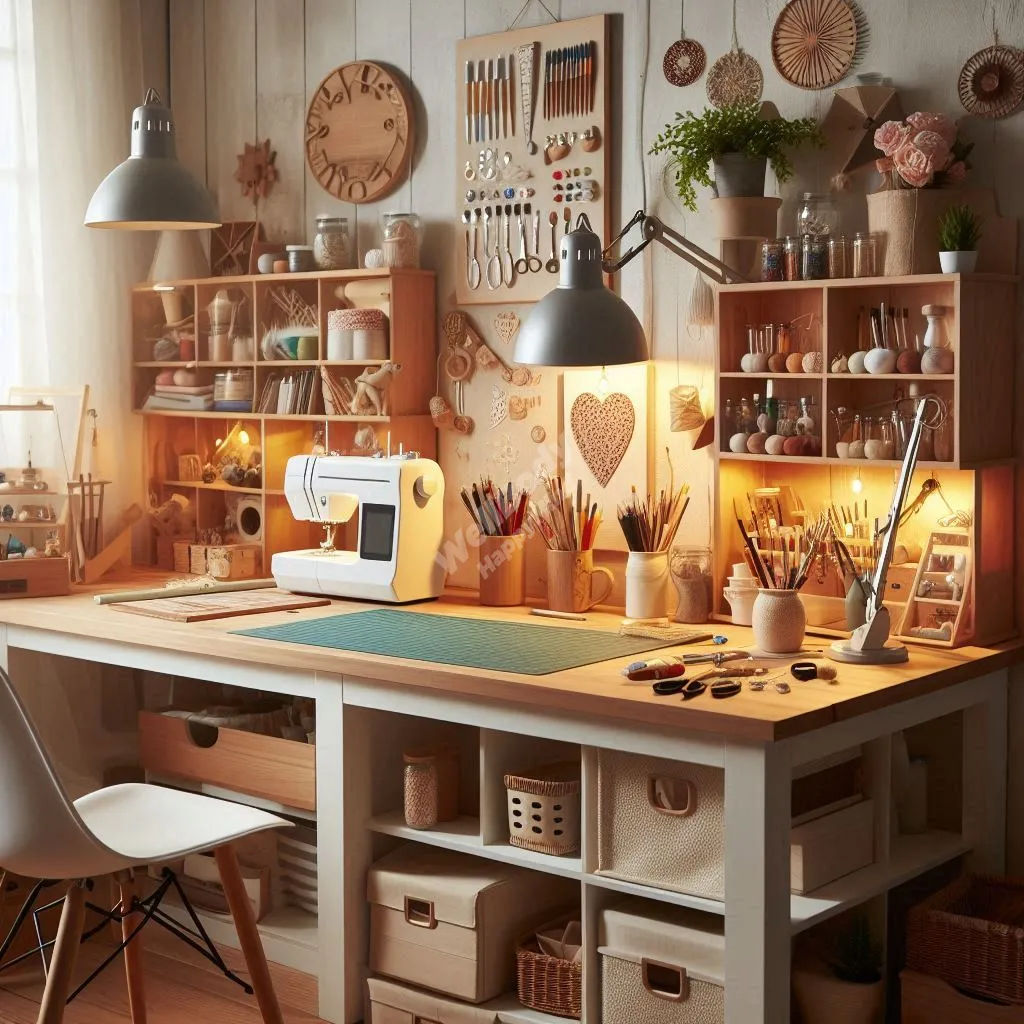
Adequate lighting is crucial for a healthy craftsmanship environment. It not only enhances the quality of your work but also protects your eye health and boosts your overall well-being.
Natural Light Optimization
Natural light is the best source of illumination for your wellness workbench. It offers several benefits:
- Improves mood and productivity
- Reduces eye strain
- Helps maintain your body’s natural circadian rhythm
To maximize natural light in your workspace:
- Position your workbench near windows
- Use light-colored, reflective surfaces
- Install skylights or solar tubes if possible
- Keep windows clean and unobstructed
Task Lighting
While natural light is ideal, it’s not always sufficient for detailed work. Task lighting provides focused illumination for specific areas or projects. Consider these options:
- Adjustable desk lamps
- Overhead directional lights
- Magnifying lamps for intricate work
- LED strip lights for under-cabinet lighting
When choosing task lighting, look for:
- Adjustable brightness levels
- Color temperature options (warm vs. cool light)
- Flexible positioning
- Energy efficiency
Remember, the goal is to create a well-lit environment that reduces eye strain and enhances your ability to focus on your craft. By combining natural light with strategic task lighting, you can create an optimal visual environment for your wellness workbench.
Air Quality Management
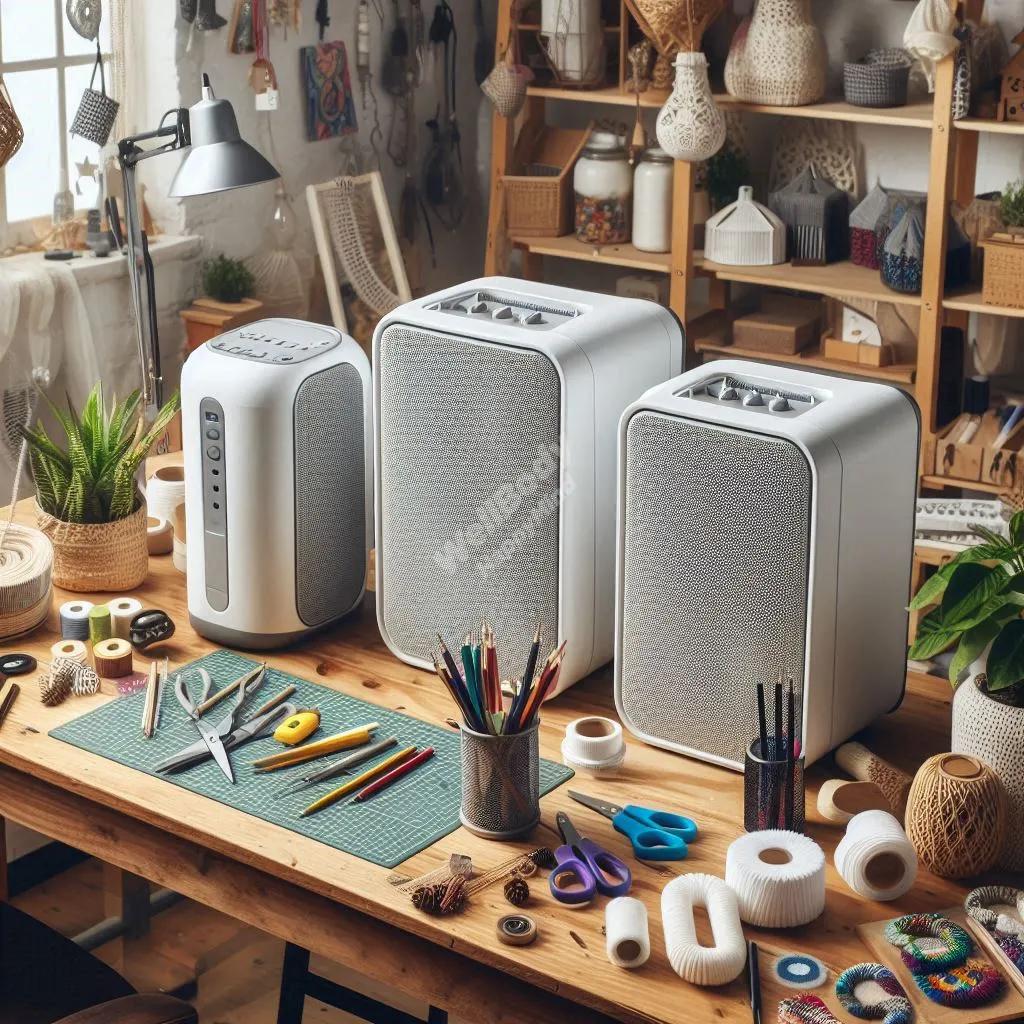
Maintaining good air quality is essential for a healthy craftsmanship environment. Many crafting activities can produce dust, fumes, or odors that may be harmful if not properly managed.
Ventilation Systems
Proper ventilation is crucial for removing airborne contaminants and maintaining a fresh, healthy workspace. Here are some options to consider:
- Exhaust fans: Remove contaminated air from the workspace
- Air exchangers: Replace stale indoor air with fresh outdoor air
- Fume extractors: Capture and remove harmful fumes at the source
- Dust collection systems: Capture airborne particles before they spread
When choosing a ventilation system, consider:
- The size of your workspace
- The types of materials you work with
- Your local climate
- Energy efficiency ratings
Air Purifiers
Air purifiers can complement your ventilation system by filtering out smaller particles and pollutants. They’re especially useful in a wellness workbench setup. When selecting an air purifier, look for these features:
- HEPA filtration for capturing fine particles
- Activated carbon filters for removing odors and gases
- Appropriate room size coverage
- Low noise operation
- Energy efficiency
Remember, good air quality not only protects your health but can also improve your focus and productivity. By investing in proper ventilation and air purification, you’re creating a cleaner, safer environment for your craft.
Noise Reduction Strategies
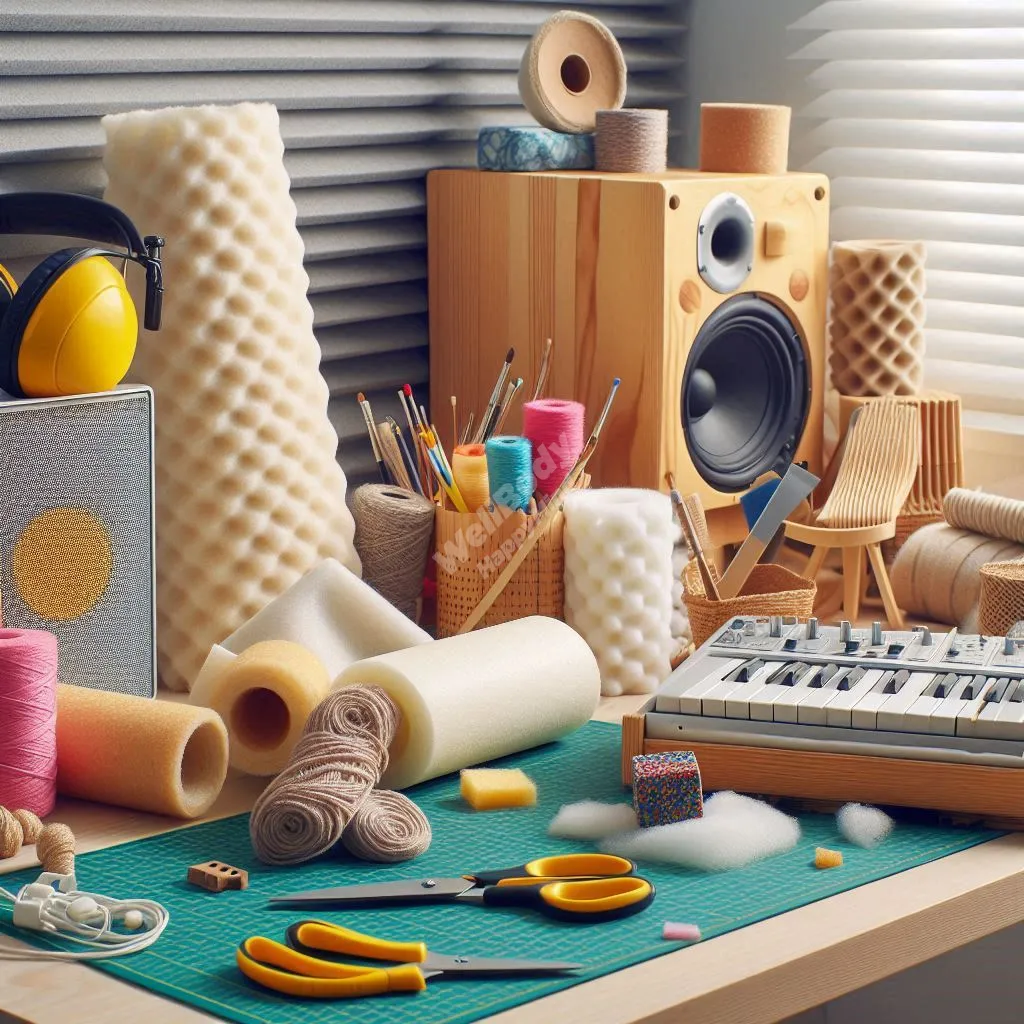
Excessive noise in your craftsmanship environment can lead to stress, fatigue, and even hearing damage over time. Implementing effective noise reduction strategies is crucial for creating a truly healthy craftsmanship environment.
Sound-absorbing Materials
Incorporating sound-absorbing materials into your workspace can significantly reduce noise levels. Here are some effective options:
- Acoustic panels: Absorb sound waves and reduce echo
- Foam tiles: Can be easily applied to walls or ceilings
- Rugs or carpets: Dampen sound reflections from hard floors
- Heavy curtains: Reduce noise from outside and absorb sound within the space
When choosing sound-absorbing materials, consider:
- The level of noise reduction needed
- Aesthetic appeal
- Ease of installation and maintenance
- Fire safety ratings
Quieter Tools and Equipment
Opting for quieter tools and equipment is another effective way to reduce noise in your wellness workbench setup. Some examples include:
- Brushless electric motors (quieter than traditional motors)
- Vibration-dampening tool mounts
- Low-noise air compressors
- Silent or near-silent generators
Tips for choosing quieter tools:
- Look for decibel (dB) ratings when comparing tools
- Read user reviews focusing on noise levels
- Consider electric options over gas-powered when possible
- Invest in quality tools that tend to run more smoothly and quietly
By implementing these noise reduction strategies, you’ll create a more peaceful and focused environment for your craft, reducing stress and protecting your hearing in the long run.
Organization and Storage Solutions
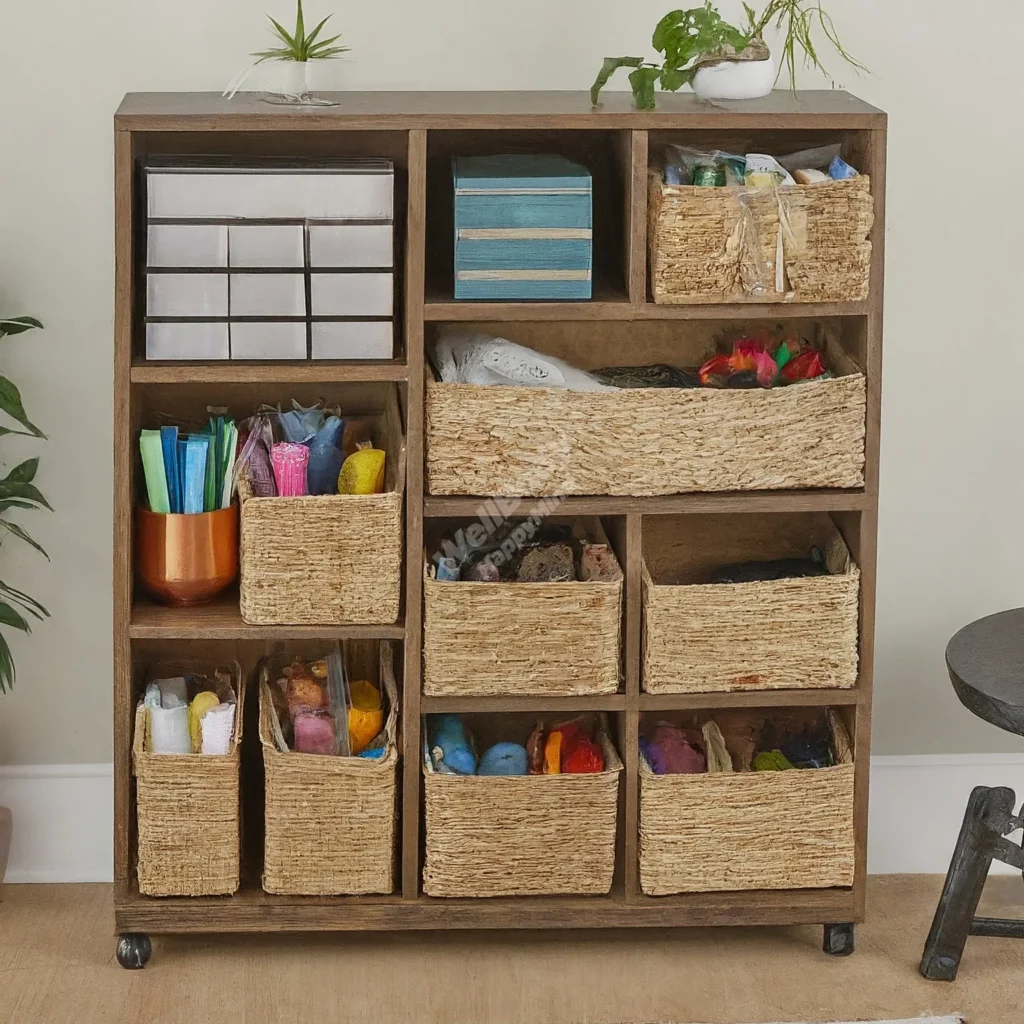
A well-organized workspace is a key component of a healthy craftsmanship environment. Proper organization not only improves efficiency but also contributes to your mental well-being and safety.
Efficient Storage Systems
Implementing efficient storage systems can transform your wellness workbench into a more productive and enjoyable space. Consider these options:
- Pegboards: Versatile for hanging tools and small items
- Magnetic strips: Great for metal tools and keeping them easily accessible
- Modular shelving: Adjustable to fit your changing needs
- Rolling carts: Provide mobile storage for frequently used items
- Drawer organizers: Keep small items sorted and easy to find
Tips for choosing storage solutions:
- Assess your specific tool and material needs
- Consider the size of your workspace
- Opt for durable materials that can withstand workshop conditions
- Choose systems that can grow or adapt with your craft
Clutter-free Workspaces
Maintaining a clutter-free workspace offers several mental health benefits:
- Reduces stress and anxiety
- Improves focus and productivity
- Enhances creativity by providing a clear space for ideas
Here are some tips for keeping your workspace clutter-free:
- Implement a “one in, one out” rule for tools and materials
- Regularly declutter and donate or sell unused items
- Create designated spaces for works-in-progress
- Clean up at the end of each work session
- Use labels to ensure everything has a clear place
Remember, an organized workspace is safer, more efficient, and more enjoyable to work in. By implementing these organization and storage solutions, you’re creating an environment that supports both your craft and your well-being.
Safety Equipment and Protocols
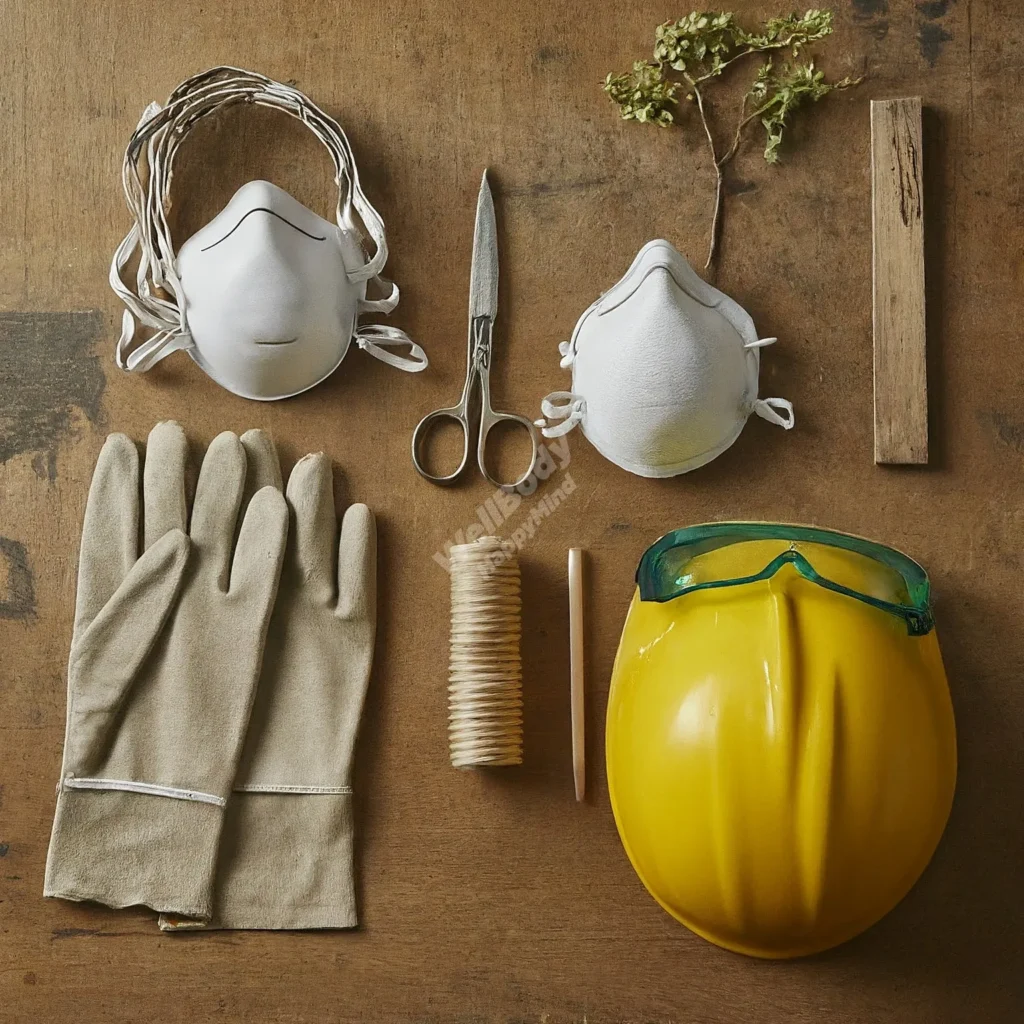
Ensuring safety is paramount in creating a healthy craftsmanship environment. Proper safety measures protect you from potential hazards and contribute to a more confident and relaxed working experience.
Personal Protective Equipment (PPE)
Personal Protective Equipment is essential for any wellness workbench. Here’s a list of essential PPE for craftsmanship environments:
- Safety glasses or goggles: Protect eyes from debris and splashes
- Hearing protection: Earplugs or earmuffs for noisy tasks
- Dust masks or respirators: Filter out harmful particles
- Work gloves: Protect hands from cuts, splinters, and chemicals
- Steel-toed boots: Safeguard feet from heavy falling objects
Remember to:
- Choose PPE that fits properly and comfortably
- Maintain and replace PPE regularly
- Use the right PPE for each specific task
First Aid and Emergency Preparedness
A well-stocked first aid kit and proper emergency protocols are crucial for any craftsmanship environment. Here’s what to include in your craft-specific first aid kit:
- Adhesive bandages in various sizes
- Sterile gauze pads
- Antiseptic wipes
- Burn gel or cream
- Eye wash solution
- Tweezers for splinter removal
- Scissors
- First aid manual
Additional emergency preparedness tips:
- Keep a fire extinguisher easily accessible
- Post emergency contact numbers in a visible location
- Create and practice an emergency evacuation plan
- Learn basic first aid and CPR
By prioritizing safety equipment and protocols, you’re not only protecting yourself but also creating a more secure and comfortable environment for your craft. This peace of mind allows you to focus more fully on your work, enhancing both your productivity and enjoyment.
Wellness Breaks and Exercises
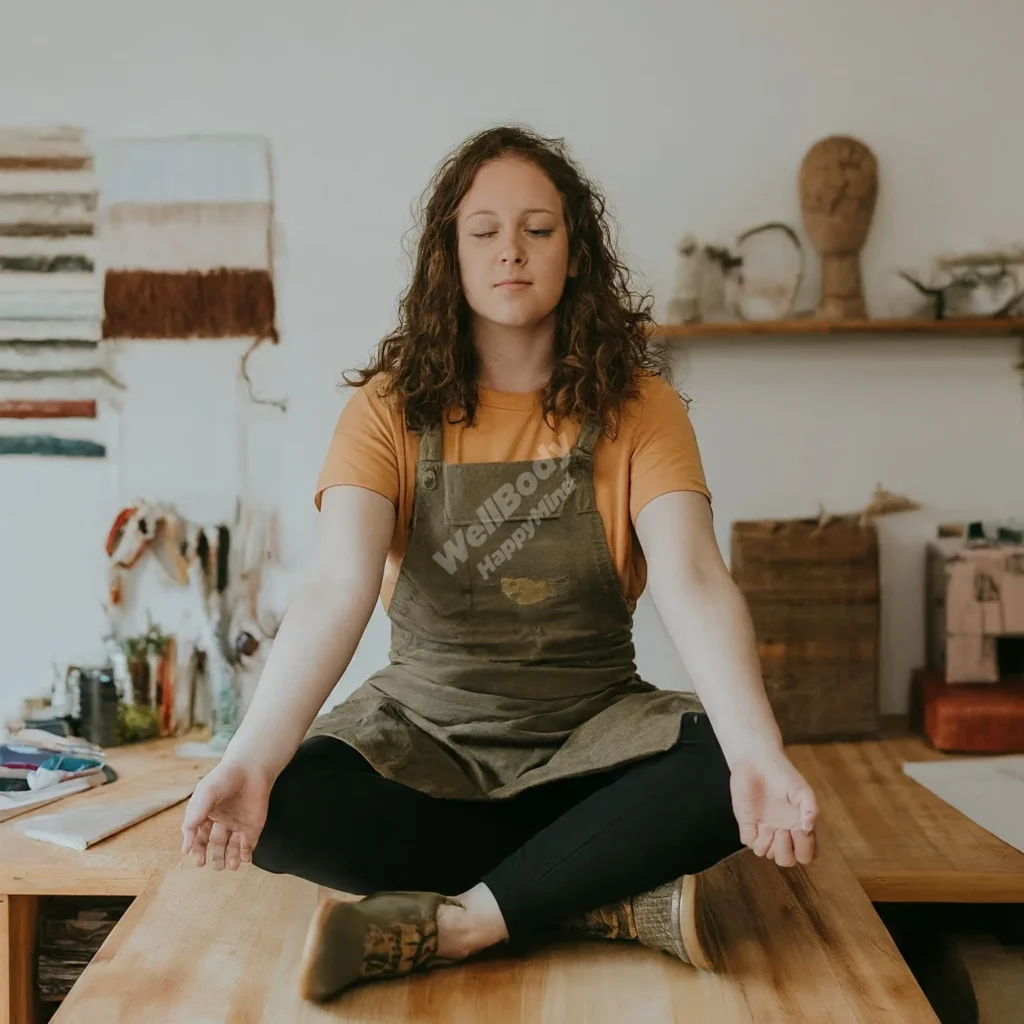
Incorporating regular breaks and exercises into your crafting routine is crucial for maintaining a healthy craftsmanship environment. These practices can help prevent physical strain, reduce stress, and boost overall well-being.
Stretching Routines
Regular stretching can help alleviate muscle tension and improve flexibility. Here’s a simple stretching routine for crafters:
- Neck rolls: Gently roll your head in a circular motion, 5 times each direction
- Shoulder shrugs: Raise your shoulders to your ears, hold for 5 seconds, then release. Repeat 5 times
- Wrist flexes: Extend your arm, gently bend your wrist back and forth, 10 times each wrist
- Finger stretches: Spread your fingers wide, then make a fist. Repeat 10 times
- Back twist: Sitting in your chair, gently twist your upper body to each side, hold for 10 seconds each side
- Ankle rotations: Lift your foot and rotate your ankle in circles, 10 times each direction, each foot
Remember to stretch gently and stop if you feel any pain.
Mindfulness Practices
Incorporating mindfulness into your crafting routine can improve focus, reduce stress, and enhance creativity. Try these quick mindfulness exercises at your wellness workbench:
- Deep breathing: Take 5 deep breaths, focusing on the sensation of air entering and leaving your body
- Body scan: Spend 1-2 minutes mentally scanning your body from head to toe, noticing any areas of tension
- Sensory awareness: Take a moment to notice 5 things you can see, 4 things you can touch, 3 things you can hear, 2 things you can smell, and 1 thing you can taste
- Gratitude practice: Think of three things you’re grateful for in your craft or workspace
- Mindful observation: Choose an object in your workspace and observe it in detail for 1 minute, as if seeing it for the first time
Aim to take short wellness breaks every 30-60 minutes, or whenever you feel tension building up. These practices will help maintain your physical and mental well-being, allowing you to enjoy your craft more fully and sustainably.
Conclusion
Creating a healthy craftsmanship environment is not just about the tools you use or the space you work in—it’s about fostering a holistic approach to your craft that prioritizes your well-being alongside your creativity.
By implementing the strategies we’ve discussed—from ergonomic tools and proper lighting to air quality management and noise reduction—you’re taking significant steps towards creating your own wellness workbench. Remember, this isn’t just about preventing health issues; it’s about enhancing your overall crafting experience and allowing your creativity to flourish in a nurturing environment.
Organizing your space, prioritizing safety, and incorporating regular wellness breaks are all integral parts of this approach. These practices not only protect your physical health but also contribute to your mental and emotional well-being, allowing you to fully immerse yourself in your craft without unnecessary stress or discomfort.
Remember, transforming your workspace into a wellness workbench is a journey, not a destination. Start with small changes and gradually implement more strategies as you go. Listen to your body, pay attention to your needs, and don’t be afraid to adjust your approach as necessary.
Call to Action
We’d love to hear about your experiences in creating a healthier craftsmanship environment. What strategies have worked best for you? Do you have any unique tips to share with fellow crafters?
Share your thoughts and experiences in the comments below. Your insights could be invaluable to others on their journey towards a more balanced and healthy approach to craftsmanship.
And don’t forget to subscribe to our blog for more content on wellness in craftsmanship and other creative pursuits. Together, we can build a community dedicated to nurturing both our crafts and our well-being.



